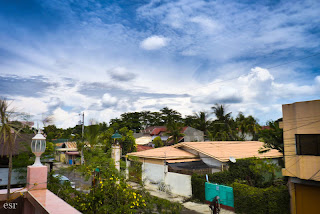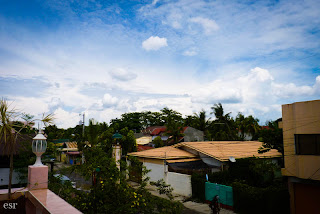I've been interested in HDR (High Dynamic Range imaging) Photography for a while.
There are some great HDR images out there, and the technique is very unique.
There are some great HDR images out there, and the technique is very unique.
Here are a few professional HDR images (all link to a post):
After browsing around and reading some tutorials, I decided to give it a try.
I needed 4 things:
In this first photo, the sky is a lovely blue, and the clouds are fluffy and white. But the rest of the neighborhood is a bit underexposed, and the light is kind of "murky" there.


But, you say, HOW in the WORLD did you do that?
It is actually quite simple.
I set my camera up on the tripod.
I turned the Aperture Priority mode on.
I correctly exposed for the sky.
Then I shot about 7 different exposures.
In some of the photos, the sky is way over exposed, but the neighborhood is lovely.
In others, the neighborhood is way underexposed, but the sky looks great.
Then I took those photos and imported them into Corel PSP, a program that is somewhat like Adobe Photoshop.
I clicked on "HDR Photo Merge" and loaded about 7 photos.
I fiddled with a few settings, and got this photo. Amazing.

(Basically all the program does is merge the images together.)
Here is another HDR photo merge that I have done (in color and black and white):
HDR is used mainly for landscape and cityscape photography. There are great things about HDR, and not so great things. If you look at the clouds in the comparison photos above, the clouds are much clearer in the original photo than in the HDR. That's because clouds move. I took 7 images and merged them together, but the clouds moved slightly in each shot, so they are blurry in the final product.
In my photo, it looks a little weird and unprofessional, but some photographers are very talented at using the moving clouds to their advantage, like in the last example I gave. (by MorBCN)
So, HDR photography is amazing. I enjoyed experimenting with it, and look forward to using it occasionally.
It is definitely not a technique that should be used all the time, but there are a few instances where it can be very well used. Why don't you give it a try?!
 |
| by Gavin Phillips |
 |
| by Leonardo Riano |
 | |
| by Nicholas Moeggenberg |
 |
| by James Brandon |
 |
| by MorBCN |
I needed 4 things:
- A camera
- A tripod
- A program that did HDR photo merges (Corel PaintShop Photo Pro X3)
- Something to photograph
In this first photo, the sky is a lovely blue, and the clouds are fluffy and white. But the rest of the neighborhood is a bit underexposed, and the light is kind of "murky" there.
But....voila! In this photo, both the sky and the neighborhood are properly exposed! Cool, right!?


But, you say, HOW in the WORLD did you do that?
It is actually quite simple.
I set my camera up on the tripod.
I turned the Aperture Priority mode on.
I correctly exposed for the sky.
Then I shot about 7 different exposures.
In some of the photos, the sky is way over exposed, but the neighborhood is lovely.
In others, the neighborhood is way underexposed, but the sky looks great.
Then I took those photos and imported them into Corel PSP, a program that is somewhat like Adobe Photoshop.
I clicked on "HDR Photo Merge" and loaded about 7 photos.
I fiddled with a few settings, and got this photo. Amazing.

(Basically all the program does is merge the images together.)
Here is another HDR photo merge that I have done (in color and black and white):
HDR is used mainly for landscape and cityscape photography. There are great things about HDR, and not so great things. If you look at the clouds in the comparison photos above, the clouds are much clearer in the original photo than in the HDR. That's because clouds move. I took 7 images and merged them together, but the clouds moved slightly in each shot, so they are blurry in the final product.
In my photo, it looks a little weird and unprofessional, but some photographers are very talented at using the moving clouds to their advantage, like in the last example I gave. (by MorBCN)
So, HDR photography is amazing. I enjoyed experimenting with it, and look forward to using it occasionally.
It is definitely not a technique that should be used all the time, but there are a few instances where it can be very well used. Why don't you give it a try?!






I love HDR photography! So glad you know how to do this...you could show me how this summer?? The images are beautiful, Lise!
ReplyDeleteCool! I wish my camera did this without me having to do anything ;-)
ReplyDeleteI've actually been to Lunken Airport in Cincinnati ...
-Dad